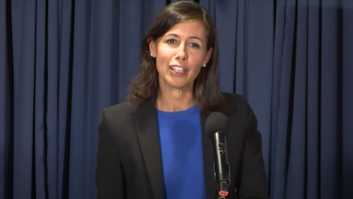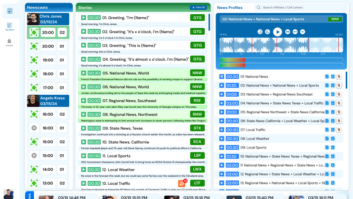Sleek, fast and ready to move
Dec 1, 2007 12:00 PM, By Chriss Scherer, editor
The showcase studio counter top is angled so lobby visitors have a better view of the operation.

The talk studio base includes a rack to mount the audio equipment, power supplies and the talk studio computer.

A prime need for the new facility was an area that could house the various remote vehicles.

One of the four audio edit suites.

The new building as seen from the street.

The technical operations center, in the engineering shop, is adjacent to the climate-controlled work bays where the remote trucks are housed. One truck can be seen through the window.

A major part of MRN”s operation, Nextel Vision produces the video entertainment for the screens at the race tracks. Josh Lieberman is at the controls.

Being quick is important for NASCAR drivers, but building a studio is a project that shouldn’t be rushed. Still, timelines and deadlines are set for a reason, and they must be met. In early October of this year, MRN Radio, the voice of NASCAR, crossed the finish line by moving to its new studio facilities. While one advantage of this move was that the facility did not support a 24-hour on-air operation, it was not simply a move across town. The studio moved 500 miles.
After many years in Daytona Beach, FL, the MRN Radio operation has relocated to Concord, NC, a suburb of Charlotte. The Daytona Beach location was used because the city is the home of NASCAR and International Speedway Corp., the parent company of MRN Radio. When it came time to rebuild the studios, it was a chance to start from a clean slate. The new studios and offices could be designed exactly to current needs. The fresh start also provided a chance to consider a new location.
So why North Carolina? For MRN Radio, the decision was fostered by the fact that many NASCAR racing teams are based in the Charlotte area. This puts MRN Radio in the heart of its core. The building that MRN Radio now occupies even has a direct tie to NASCAR: It previously housed Darrel Waltrip’s race shop.
Planning the move
When planning for the new facility began, MRN Radio Chief Engineer Doug Watson was able to take the fresh start and build exactly the facility the network needed. This started with locating the right building. Obvious factors, such as sufficient space for the studios, business and operations staff were a given. One important consideration for the new facility was not based on the studios and staff, but rather the MRN vehicles.
MRN Radio operates four vehicles to cover racing events around the country. Like any remote vehicle, these rolling studios require occasional maintenance. What’s different about these vehicles is that they are not the traditional panel vans like most radio stations operate. Two of them are 53′ long semi trailers. There is also a satellite uplink truck and an 18′ trailer that is pulled by a pickup truck. These complete mobile studios are in constant use during each season, so the time to give them the heaviest maintenance is during the off-season in December and January. Working on them outside is not a preferred method, especially during the winter. A garage able to house both vehicles was on the required needs list. In the end, finding a building with a previous tie to NASCAR was just an added bonus.
Covering nearly 25,000 square feet, the facility includes a garage that measures 41′ wide by 157′ long (about 6,440 square feet). When Waltrip used it, the building had six office spaces in the front, while the remainder was used for the car shop. MRN Radio kept the existing front offices and integrated them into the floor plan. Additional offices were built, as well as two control rooms, two talk studios, a production studio, four identical audio edit suites, three identical video edit suites and a rack room in the open area.
There are two large spaces currently used for storage. Both measure just over 1,500 square feet and provide plenty of expansion space for the future.
The two air studios and talk studios are built in a mirrored fashion. The main reason for this was to provide natural redundancy for the on-air operations. While they are functionally identical, they are not completely cosmetically the same. The studio nearer to the entrance was built to be a showcase, and it is visible from the lobby. The other air studio is toward the rear of the building and does not have the same public visibility.
While the front studio has large windows looking into the lobby, the showcase design was also applied to the furniture itself. The control room counter top is not parallel with the wall looking into the talk studio. Instead it is slightly angled to show more of the console surface when viewed from the lobby. The talk studio table is also angled to avoid having one guest’s back directly toward the lobby window. The control rooms and talk studios measure about 20′ by 11′.
The production studio, while in place, is not yet built completely. The redundant air studios and edit suites provide sufficient capability to serve the network’s needs for now. Except for the studio furniture, the room stands empty now.
New facility, new technology
The long-distance move covered not only many miles, but also a large technology gap. The old studios were built around traditional audio production consoles, not broadcast consoles. Each studio was a stand-alone island, and each operator had a plethora of knobs and buttons in front of him. The operators learned what each was for, but this is still a radio facility. The new studios would have radio consoles. Watson chose Axia Livewire with Radio Systems Studio Hub+ interconnects for the job.
Built on Studio Technology furniture, the cosmetic difference alone compared to the previous facility exemplifies the technology jump. The operators had to learn a completely new approach to audio routing and control. While the previous consoles had many controls at the user’s fingertips, the Axia surfaces place many of these controls under menus because they are not really needed that often. In addition, the operators had to learn a new automation system as a Google SS32 system was installed in the new facility. The installation of the new audio systems also provide a simplified means of routing audio.
Watson and the installation crew quickly learned another advantage to installing a networked audio system: installation time. In this case, there were fewer wires to strip and connectors to attach because of the extensive use of pre-fab RJ-45 cables.

The floor plan of the new facility.
Click image to enlarge
The rack room is in the engineering shop, and it houses the expected audio codecs, computers and other equipment, as well as the satellite uplink and downlink equipment. The satellite dishes are mounted behind the building. MRN Radio is currently using a temporary C-band uplink from NPR Satellite Services until the network’s uplink license is granted by the FCC.
Backup power is provided by a 150kVa generator. The generator also supplies power to a 80kVa UPS system that feeds the air studios, one audio edit suite, one video edit suite and the rack room. Because of its back-up power and location, the facility will also serve as a back-up data center for International Speedway Corp. in Daytona. This will provide an off-site back-up should the Daytona facility go off line.
The project followed a fairly strict schedule, and it went live on Oct. 2, 2007. The first show to originate from the new facility was NASCAR Live. When all went well with that show, it was decided to originate Sirius Speedway from the new location on Oct. 3, but some unexpected difficulties arose, so that day’s program was transferred back to Daytona. The bugs were fixed, and Sirius Speedway officially moved to Concord on Oct. 4. The Daytona facility was left in place for a week as a back-up, but no problems arose.
Studio dedication
The two air studios have been dedicated to two people with long histories with MRN Radio. MRN A was dedicated to Barney Hall, one of the original MRN announcers. He started with the company when it was formed in 1970.
MRN B was dedicated to Harry O. Howard. Howard was the chief engineer of MRN from 1974 to 2007. He retired when the network moved to Concord.
Equipment list
Adobe Audition 2.0
Airtools 6100
Aphex 320D
Axia Element
Burk GS3000
Dell Computers
ESE ES185 GPS clock
EV RE 20
Google SS32
Luxo 13610
Media Technology Group-James Nance, Accoustical Consultant
Middle Atlantic racks and accessories
Studio Hub+ panels, headphone amps
Studio Technology furniture
Tannoy Reveal 5A, 6A
Tascam CD-RW901, MD-350
Telos Assistant Producer, Desktop Director, NX12, Xstream
Wohler AMP1A-4PLS
Yellowtec Mika
Equipment dealers
BGS
Crouse-Kimzey
Read about one of the remote vehicles
http://radiomagonline.com/automation/radio_road_motor_racing/index.html











